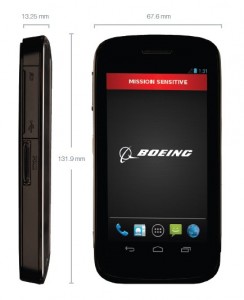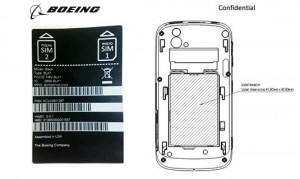

| The Boeing Black phone is manufactured as a sealed device both with epoxy around the casing and with screws, the heads of which are covered with tamper proof covering to identify attempted disassembly. Any attempt to break open the casing of the device would trigger functions that would delete the data and software contained within the device and make the device inoperable. |
Two years later, present day, Boeing filed papers with the FCC included a request for secrecy in order to evolve this super-secure smartphone, the Boeing Black (H8V-BLK1). For “people in the business of secrets”, spies, the military (and other exclusive companies), the device, running Android, will “self-destruct” if one tries to tamper with it. It contains unusual safeguards, and duplicate SIM cards in order to do what it does best, operate on multiple wireless networks at once.
Primarily, Black is constructed for guarded communications amidst governmental agencies and their contractors. In fact, the the FCC filing Boeing wrote:


So no, not just anyone could purchase and use this device. Boeing’s Purchase Agreement is also required, and in it states that the components, and hardware are to be protected as “proprietary information”. And any attempt to replace or service parts will not work, only destroy the product, as mentioned in an above statement.
Not everything is a secret, though. There are known facts based on the filing, and thanks to brochures from Boeing, they have relayed some specifications on the smartphone. The device sports a 4.3-inch screen, and dual 1.2GHz ARM Cortex APU processors. The dual-MicroSIM supports Global System for Mobile Communications (GSM), Wideband Code Division Multiple Access (WCDMA), and LTE on broad ranges for global use. Wi-Fi and Bluetooth connectivity will also be featured; equipped with USB, HDMI, and PDMI ports. The phone is also modular. Owners are able to use an expansion port for adding sensors, enhancements, and supplements for security, such as bolstered power and satellite connectivity. The only news of cost seems to involve an incredible price of $15,000 to $20,000 a piece. Yet, wouldn’t we expect something with “governmental and military grade” security to have such an immense payout, especially from a huge contractor for US aircraft and combat systems? Not too terribly surprising. One question, will it have a “flight mode”, or voluntarily combust?

 Laptop & Tablet Parts
Laptop & Tablet Parts




















